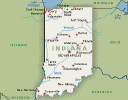
INQP accepts logs in any readable form, but we strongly prefer the Cabrillo format. Cabrillo logs can be scanned and verified quickly. Other log formats are manually converted to Cabrillo, and that gets to be a lot of extra work.
A sample Cabrillo log is seen below. The columns for the QSO data must be separated by spaces or tabs. The start and end positions for each column do not matter but each column must fall into the proper order as seen in the example. It is not necessary for the columns to line up (it looks pretty, but the computer does not care).
START-OF-LOG: 2.0 ARRL-SECTION: IN CALLSIGN: N9LF CATEGORY: SINGLE-OP ALL HIGH MIXED CLAIMED-SCORE: 36 CLUB: Society of Midwest Contesters CONTEST: IN QSO Party CREATED-BY: WriteLog V10.59D NAME: Tim Gardner ADDRESS: 923 South 20th St ADDRESS: Lafayette, IN 47905 OPERATORS: N9LF SOAPBOX: QSO: 7019 CW 2006-05-07 0241 N9LF 599 TIPP,BEN W1AW 599 CT QSO: 7234 PH 2006-05-07 0242 N9LF 59 WHTE W9IU 59 SHE HAN END-OF-LOG:
1) Each QSO record should be on a single line of text.
2) The Cabrillo header may contain quite a bit of information, but only CALLSIGN and OPERATORS are required. Other fields are helpful, but not mandatory.
3) The INQP rules state that when operating on a county border, you should log two QSOs. Likewise when you work a station on a county border, you should log two qsos. The Cabrillo files generated by most logging programs record only one QSO and list each county. The sample QSOs above show how WriteLog records such QSOs, but other logging programs produce similar results.
You may use either logging method. The INQP log checking software recognizes both methods and awards the appropriate points and multipliers in either case.
4) The official Cabrillo spec is found here:
5) Not all logging programs will create Cabrillo files in the format shown in the example. Send it anyway - we will make it work.